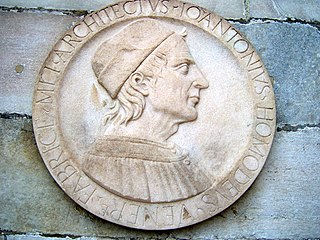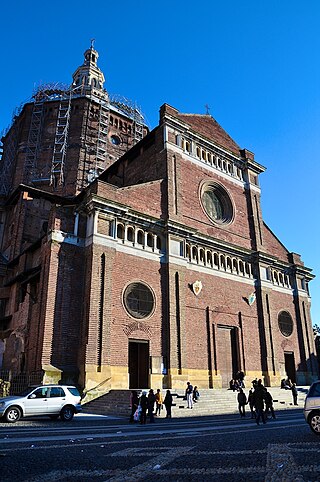Francesco di Riccardo Sacchetti (died in or before 1473), a member of an illustrious Tuscan family, was a doctor of medicine and professor of logic and law at the University of Pavia, Italy from 1449-69. [1]
His son, Francesco di Francesco Sacchetti, a minor in 1473, was also a doctor of arts and medicine; he was taken prisoner after the battle of Pavia, 1525, and seems to have died in captivity in Naples. [2]

Baldus de Ubaldis was an Italian jurist, and a leading figure in Medieval Roman Law and the school of Postglossators.

Vincenzo Foppa was an Italian painter from the Renaissance period. While few of his works survive, he was an esteemed and influential painter during his time and is considered the preeminent leader of the Early Lombard School. He spent his career working for the Sforza family, Dukes of Milan, in Pavia, as well as various other patrons throughout Lombardy and Liguria. He lived and worked in his native Brescia during his later years.

Giovanni Antonio Amadeo was an Italian Renaissance sculptor of the Early Renaissance, architect, and engineer. He dominated late fifteenth-century Lombard architecture and sculpture.

Albert IV was Duke of Bavaria-Munich from 1467, and duke of the reunited Bavaria from 1503.

The Certosa di Pavia is a monastery complex in Lombardy, Northern Italy, situated near a small village of the same name in the Province of Pavia, 8 km (5.0 mi) north of Pavia. Built from 1396 to 1495, it was once located at the end of the Visconti Park a large hunting park and pleasure ground belonging to the Visconti dukes of Milan, of which today only scattered parts remain. It is one of the largest monasteries in Italy.

Francis III was Dauphin of France and, after 1524, Duke of Brittany. Francis and his brother, Henry, were exchanged as hostages for their father, Francis I, who had been captured at the Battle of Pavia. They would be hostages for three years. Made duke of Brittany in 1532, this precipitated Brittany's integration with the Kingdom of France. Francis died 10 August 1536, possibly from tuberculosis.

The University of Insubria is an Italian university located in Como and Varese, with secondary locations in Busto Arsizio and Saronno. It was founded in 1998, it has been named after the area where it is situated, the historical-geographical region of Insubria.

Marcus Antonius Coccius Sabellicus or Marcantonio Sabellico (1436–1506) was a scholar and historian from Venice. He is known for his universal history, Enneades sive Rhapsodia historiarum.

The Diocese of Frascati is a Latin suburbicarian see of the Diocese of Rome and a diocese of the Catholic Church in Italy, based at Frascati, near Rome. The bishop of Frascati is a Cardinal Bishop; from the Latin name of the area, the bishop has also been called Bishop of Tusculum. Tusculum was destroyed in 1191. The bishopric moved from Tusculum to Frascati, a nearby town which is first mentioned in the pontificate of Pope Leo IV. Until 1962, the Cardinal-Bishop was concurrently the diocesan bishop of the see. Pope John XXIII removed the Cardinal Bishops from any actual responsibility in their suburbicarian dioceses and made the title purely honorific.
The decade of the 1470s in art involved some significant events.

The Diocese of Pavia is a Latin diocese of the Catholic Church in Italy. It has been a suffragan of the Archdiocese of Milan only since 1817. Previous to the reorganization of the hierarchy in northern Italy by Pope Pius VII after the expulsion of the French and the Congress of Vienna, the diocese of Pavia had depended directly upon the Holy See, despite repeated failed attempts on the part of the Archbishops of Milan to claim control. The diocese has produced one Pope and Patriarch of Venice, and three cardinals.

Giovanni Battista Monteggia was an Italian surgeon. The Monteggia fracture is named after him.
Sacchetti may refer to:

Bernardino de 'Conti was an Italian Renaissance painter, born in 1465 in Castelseprio and died around 1525.

Giasone del Maino (1435–1519) was an Italian jurist. With his pupil Filippo Decio he was one of the last of the Bartolist commentators on Roman law.

Philip I of Croÿ-Chimay, count of Chimay, Lord of Quiévrain, was a noble from the House of Croÿ, in the service of the Dukes of Burgundy.

Giovanni Arcimboldi, called the Cardinal of Novara or the Cardinal of Milan, was an Italian Roman Catholic bishop and cardinal. He served many times as the legate to Perugia and was both a Senator of Milan and ran the archdiocese from 1485–1488.

The Sacchetti family is an Italian noble family originating in Tuscany, now resident in Rome, whose earliest documented member Merlo lived during the late 10th and early 11th centuries. The name of the family is derived from one or more members known as Sacchetto. According to Ugolino di Vieri (1438–1516),"nobile Sacchetti genus est, moenia primus romanus sangius".
Agostino Dati, also known as Augustinus Datus or Dathus was a fifteenth-century orator, historian and philosopher best known for his grammatical textbook Elegantiolae. In 1489 Erasmus praised Dati as one of the Italian masters of eloquence.
Anselmus Ephorinus was a Silesian humanist and doctor.